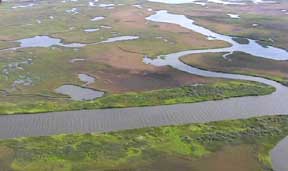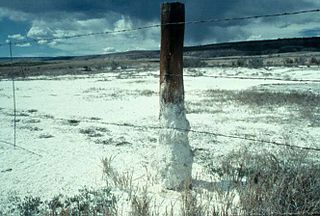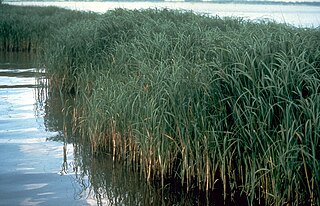
A halophyte is a salt-tolerant plant that grows in waters of high salinity, coming into contact with saline water through its roots or by salt spray, such as in saline semi-deserts, mangrove swamps, marshes and sloughs and seashores. These plants do not prefer saline environments but because of their ability to cope with high salinity in various ways they face much less competition in these areas. The word derives from Ancient Greek ἅλας (halas) 'salt' and φυτόν (phyton) 'plant'. An example of a halophyte is the salt marsh grass Spartina alterniflora. Relatively few plant species are halophytes—perhaps only 2% of all plant species.

Plant nutrition is the study of the chemical elements and compounds necessary for plant growth, plant metabolism and their external supply. In 1972, Emanuel Epstein defined two criteria for an element to be essential for plant growth:
- in its absence the plant is unable to complete a normal life cycle.
- or that the element is part of some essential plant constituent or metabolite.
Anaerobic respiration is respiration using electron acceptors other than molecular oxygen (O2). Although oxygen is not the final electron acceptor, the process still uses a respiratory electron transport chain.

Oxygen saturation is a relative measure of the concentration of oxygen that is dissolved or carried in a given medium as a proportion of the maximal concentration that can be dissolved in that medium. It can be measured with a dissolved oxygen probe such as an oxygen sensor or an optode in liquid media, usually water. The standard unit of oxygen saturation is percent (%).

Soil conservation is the preventing of soil loss from erosion or reduced fertility caused by over usage, acidification, salinization or other chemical soil contamination.

Spartina alterniflora, the smooth cordgrass, saltmarsh cordgrass, or salt-water cordgrass, is a perennial deciduous grass which is found in intertidal wetlands, especially estuarine salt marshes. It has been reclassified as Sporobolus alterniflorus after a taxonomic revision in 2014, but Spartina alterniflora is still in common usage. It grows 1–1.5 m (3.3–4.9 ft) tall and has smooth, hollow stems that bear leaves up to 20–60 cm (7.9–23.6 in) long and 1.5 cm wide at their base, which are sharply tapered and bend down at their tips. Like its relative saltmeadow cordgrass S. patens, it produces flowers and seeds on only one side of the stalk. The flowers are a yellowish-green, turning brown by the winter. It has rhizoidal roots, which, when broken off, can result in vegetative asexual growth. The roots are an important food resource for snow geese. It can grow in low marsh as well as high marsh, but it is usually restricted to low marsh because it is outcompeted by salt meadow cordgrass in the high marsh. It grows in a wide range of salinities, from about 5 psu to marine, and has been described as the "single most important marsh plant species in the estuary" of Chesapeake Bay. It is described as intolerant of shade.
Ecological facilitation or probiosis describes species interactions that benefit at least one of the participants and cause harm to neither. Facilitations can be categorized as mutualisms, in which both species benefit, or commensalisms, in which one species benefits and the other is unaffected. Much of classic ecological theory has focused on negative interactions such as predation and competition, but positive interactions (facilitation) are receiving increasing focus in ecological research. This article addresses both the mechanisms of facilitation and the increasing information available concerning the impacts of facilitation on community ecology.

In ecology, a halosere is a succession in a saline environment. An example of a halosere is a salt marsh.

Aerenchyma is a spongy tissue that forms spaces or air channels in the leaves, stems and roots of some plants, which allows exchange of gases between the shoot and the root. The channels of air-filled cavities provide a low-resistance internal pathway for the exchange of gases such as oxygen and ethylene between the plant above the water and the submerged tissues. Aerenchyma is also widespread in aquatic and wetland plants which must grow in hypoxic soils.
California's coastal salt marsh is a wetland plant community that occurs sporadically along the Pacific Coast from Humboldt Bay to San Diego. This salt marsh type is found in bays, harbors, inlets, and other protected areas subject to tidal flooding.
Soil respiration refers to the production of carbon dioxide when soil organisms respire. This includes respiration of plant roots, the rhizosphere, microbes and fauna.
Soil biodiversity refers to the relationship of soil to biodiversity and to aspects of the soil that can be managed in relation to biodiversity. Soil biodiversity relates to some catchment management considerations.

Forest dieback is a condition in trees or woody plants in which peripheral parts are killed, either by pathogens, parasites or due to conditions like acid rain and drought. Two of the nine tipping points for major climate changes, forecast for the next century, are directly related to forest diebacks.
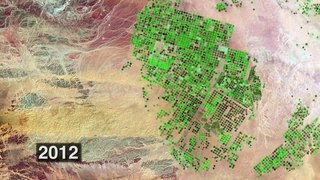
The environmental impacts of irrigation relate to the changes in quantity and quality of soil and water as a result of irrigation and the effects on natural and social conditions in river basins and downstream of an irrigation scheme. The impacts stem from the altered hydrological conditions caused by the installation and operation of the irrigation scheme.
Low marsh is a tidal marsh zone. It is characterized as being flooded daily.

Salt pannes and pools are water retaining depressions located within salt and brackish marshes. Pools tend to retain water during the summer months between high tides, whereas pannes generally do not. Salt pannes generally start when a mat of organic debris is deposited upon existing vegetation, killing it. This creates a slight depression in the surrounding vegetation which retains water for varying periods of time. Upon successive cycles of inundation and evaporation the panne develops an increased salinity greater than that of the larger body of water. This increased salinity dictates the type of flora and fauna able to grow within the panne. Salt pools are also secondary formations, though the exact mechanism(s) of formation are not well understood; some have predicted they will increase in size and abundance in the future due to rising sea levels.
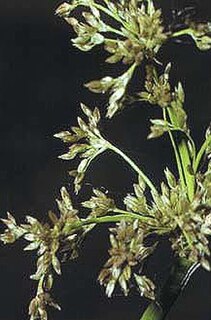
Juncus roemerianus is a species of flowering plant in the rush family known by the common names black rush, needlerush, and black needlerush. It is native to North America, where its main distribution lies along the coastline of the southeastern United States, including the Gulf Coast. It occurs from New Jersey to Texas, with outlying populations in Connecticut, New York, Mexico, and certain Caribbean islands.
The carbon cycle is an essential part of life on Earth. About half the dry weight of most living organisms is carbon. It plays an important role in the structure, biochemistry, and nutrition of all living cells. Living biomass holds about 550 gigatons of carbon, most of which is made of terrestrial plants (wood), while some 1,200 gigatons of carbon are stored in the terrestrial biosphere as dead biomass.

Salt marsh die-off is a term that has been used in the US and UK to describe the death of salt marsh cordgrass leading to subsequent degradation of habitat, specifically in the low marsh zones of salt marshes on the coasts of the Western Atlantic. Cordgrass normally anchors sediment in salt marshes; its loss leads to decreased substrate hardness, increased erosion, and collapse of creek banks into the water, ultimately resulting in decreased marsh health and productivity.
